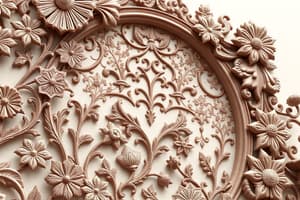Podcast
Questions and Answers
What is one common action required before building a part?
What is one common action required before building a part?
- Verify the part is correct (correct)
- Change the color of the part
- Use the machine to build automatically
- Add additional parts without checking
Unusual cases may require segmentation of STL files.
Unusual cases may require segmentation of STL files.
True (A)
What type of tools are available for STL file manipulation?
What type of tools are available for STL file manipulation?
Software tools for purchase or free download
In the AM process, parts may require ______ or coating allowances.
In the AM process, parts may require ______ or coating allowances.
What happens if an incorrect setup procedure is followed in an AM machine?
What happens if an incorrect setup procedure is followed in an AM machine?
Match the following stages of the AM process with their descriptions:
Match the following stages of the AM process with their descriptions:
All AM machines operate with the same number of setup parameters.
All AM machines operate with the same number of setup parameters.
The AM procedure includes a ______ based manufacturing process.
The AM procedure includes a ______ based manufacturing process.
What does STL stand for in the context of additive manufacturing?
What does STL stand for in the context of additive manufacturing?
The process of converting CAD models to STL files is manual in most CAD systems.
The process of converting CAD models to STL files is manual in most CAD systems.
Name one application area of additive manufacturing that does not involve conventional CAD modeling.
Name one application area of additive manufacturing that does not involve conventional CAD modeling.
The eight steps in the AM process chain include conceptualization and CAD, conversion to STL, transfer to AM machine, __________, build, part removal and cleanup, post-processing of part, and application.
The eight steps in the AM process chain include conceptualization and CAD, conversion to STL, transfer to AM machine, __________, build, part removal and cleanup, post-processing of part, and application.
Match the following AM machine types with their characteristics:
Match the following AM machine types with their characteristics:
What is a key consideration in the design for additive manufacturing?
What is a key consideration in the design for additive manufacturing?
Metal systems in additive manufacturing do not require consideration of weight and speed.
Metal systems in additive manufacturing do not require consideration of weight and speed.
STL files approximate the surface of a CAD model with a series of __________.
STL files approximate the surface of a CAD model with a series of __________.
What is often required during the removal of support structures in additive manufacturing (AM)?
What is often required during the removal of support structures in additive manufacturing (AM)?
Post-processing stages in additive manufacturing require no manual work.
Post-processing stages in additive manufacturing require no manual work.
What are the typical finishing processes involved in post-processing?
What are the typical finishing processes involved in post-processing?
Some AM machines need __________ structures to prevent part collapse during the building process.
Some AM machines need __________ structures to prevent part collapse during the building process.
Match the following terms to their descriptions:
Match the following terms to their descriptions:
Why do AM parts often not behave according to standard material specifications?
Why do AM parts often not behave according to standard material specifications?
The number of applications for AM output is decreasing as technologies improve.
The number of applications for AM output is decreasing as technologies improve.
What can cause material degradation during the AM process?
What can cause material degradation during the AM process?
What is the typical nominal layer thickness for most additive manufacturing machines?
What is the typical nominal layer thickness for most additive manufacturing machines?
Thicker layers in additive manufacturing result in quicker builds but more precision.
Thicker layers in additive manufacturing result in quicker builds but more precision.
What must be considered during post-processing involving heat in additive manufacturing?
What must be considered during post-processing involving heat in additive manufacturing?
In photopolymer-based systems, all liquid vat systems must use support from the same material as that used for the ______.
In photopolymer-based systems, all liquid vat systems must use support from the same material as that used for the ______.
Match the following additive manufacturing system types with their characteristics:
Match the following additive manufacturing system types with their characteristics:
What is one advantage of newer resins used in photopolymer systems?
What is one advantage of newer resins used in photopolymer systems?
Binder printing into a powder bed creates unique parts in additive manufacturing.
Binder printing into a powder bed creates unique parts in additive manufacturing.
What common issue may arise with fine details in designs during additive manufacturing?
What common issue may arise with fine details in designs during additive manufacturing?
Which technology is commonly used for architectural modeling to enhance designs?
Which technology is commonly used for architectural modeling to enhance designs?
The STL file format works well with all additive manufacturing processes.
The STL file format works well with all additive manufacturing processes.
What future trend is expected in additive manufacturing regarding materials?
What future trend is expected in additive manufacturing regarding materials?
The process of using a combination of additive and subtractive methods in manufacturing is known as ______.
The process of using a combination of additive and subtractive methods in manufacturing is known as ______.
Match the following components of additive manufacturing with their descriptions:
Match the following components of additive manufacturing with their descriptions:
What process requires the generation of support structures for droplet-based systems?
What process requires the generation of support structures for droplet-based systems?
Solid sheets in lamination methods do not require support structures.
Solid sheets in lamination methods do not require support structures.
Name one aspect that must be carefully monitored in certain 3D printing machines.
Name one aspect that must be carefully monitored in certain 3D printing machines.
Exposure to ________ should be avoided during material handling.
Exposure to ________ should be avoided during material handling.
Which of the following is NOT a consideration for Metal Systems compared to polymer systems?
Which of the following is NOT a consideration for Metal Systems compared to polymer systems?
Match the following application areas with their relevant technologies:
Match the following application areas with their relevant technologies:
What design considerations help with additive manufacturing processes?
What design considerations help with additive manufacturing processes?
Machines should not be used in ________ or ________ environments to avoid malfunction.
Machines should not be used in ________ or ________ environments to avoid malfunction.
Flashcards
STL File
STL File
A file format used to represent a 3D model as a collection of triangles, commonly used in additive manufacturing. It describes the model's geometry without any information about material properties or colors.
Conceptualization
Conceptualization
The initial stage of product development, involving the generation of ideas and concepts for a new product, often through sketches, descriptions, or 3D models.
CAD Model
CAD Model
A digital representation of a 3D object created using computer-aided design software, used to design and create various objects, from simple shapes to complex products.
Transfer to AM Machine
Transfer to AM Machine
Signup and view all the flashcards
Part Removal and Cleanup
Part Removal and Cleanup
Signup and view all the flashcards
Machine Setup
Machine Setup
Signup and view all the flashcards
Post-Processing
Post-Processing
Signup and view all the flashcards
Application
Application
Signup and view all the flashcards
Part Verification
Part Verification
Signup and view all the flashcards
Visualization Tool
Visualization Tool
Signup and view all the flashcards
Part Repositioning
Part Repositioning
Signup and view all the flashcards
Multiple Part Building
Multiple Part Building
Signup and view all the flashcards
Shrinkage and Coating Allowances
Shrinkage and Coating Allowances
Signup and view all the flashcards
STL File Segmentation
STL File Segmentation
Signup and view all the flashcards
Machine Setup Parameters
Machine Setup Parameters
Signup and view all the flashcards
Semi-Automated Build
Semi-Automated Build
Signup and view all the flashcards
Support Structures
Support Structures
Signup and view all the flashcards
Support Removal
Support Removal
Signup and view all the flashcards
Anisotropic Properties
Anisotropic Properties
Signup and view all the flashcards
Voids or Bubbles
Voids or Bubbles
Signup and view all the flashcards
Material Degradation
Material Degradation
Signup and view all the flashcards
Application of AM Parts
Application of AM Parts
Signup and view all the flashcards
Expanding Applications
Expanding Applications
Signup and view all the flashcards
Reverse Engineering
Reverse Engineering
Signup and view all the flashcards
Laser Scanning
Laser Scanning
Signup and view all the flashcards
Architectural Modeling
Architectural Modeling
Signup and view all the flashcards
AM Processing Optimization
AM Processing Optimization
Signup and view all the flashcards
Direct Digital Manufacturing
Direct Digital Manufacturing
Signup and view all the flashcards
Layer Thickness
Layer Thickness
Signup and view all the flashcards
Fine Details in AM
Fine Details in AM
Signup and view all the flashcards
Material Variation in AM
Material Variation in AM
Signup and view all the flashcards
Support Structures in Photopolymer
Support Structures in Photopolymer
Signup and view all the flashcards
Support Material in Droplet Deposition
Support Material in Droplet Deposition
Signup and view all the flashcards
Advantages of Photopolymer AM
Advantages of Photopolymer AM
Signup and view all the flashcards
Powder-Based AM Support Structures
Powder-Based AM Support Structures
Signup and view all the flashcards
Colored Binder Printing
Colored Binder Printing
Signup and view all the flashcards
Study Notes
Generalized Additive Manufacturing Process Chain
- The process chain involves several key stages
- Key steps include conceptualization and CAD, STL conversion, file transfer, machine setup, building, part removal, cleanup, post-processing, and application
- Variations exist between different AM machines related to photopolymer, powder-based, and molten material systems, and solid sheets
- Variations can be observed in substrate choice, energy density, weight, accuracy, and speed during the manufacturing process
- Maintenance of equipment and material handling are essential considerations, and design for AM (part orientation, support removal, hollowing out parts, undercuts, etc.) plays a crucial part
- There are specified applications that do not involve conventional CAD modeling. These include medical modeling, reverse engineering data, and architectural modeling.
Eight Steps in AM
- Conceptualization and CAD: Idea generation, product visualization (textual & narrative, sketches, or 3D CAD)
- Conversion to STL: Sterolithography-derived, describes CAD model using triangular facets. Automated in most CAD systems
- Transfer to AM Machine & STL File Manipulation: Transferring STL file, verification, repositioning, and manipulation for building
- Machine Setup: Setup parameters specific to the machine, options for material and layer thickness variation
- Build: Semi-automated initial stages, followed by computer control, layer creation, and platform adjustments, until completion or material exhaustion
- Removal and Cleanup: Separating the part from the build platform and excess material, supporting structures removal, possible manual intervention.
- Post-processing: Finishing for application purposes (abrasive finishing, coatings), application specific, and possible need for power tools and auxiliary equipment (polishing tubs, ovens)
- Application: Post-processing, material behavior considerations, and the constant increase of applications for AM processes
Variations from One AM Machine to Another
- Photopolymer-Based Systems: Easy setup, potential support modification, accuracy, and limited mechanical properties
- Powder-Based Systems: No support needed, layer-by-layer deposition, achievable coloring
- Molten Material Systems: Support structure generation varies based on the process, e.g. automatic or user-generated
- Solid Sheets: No support needed, waste material management critical, and method-specific considerations in the final part appearance
- Metal Systems: Considerations for subtractive manufacturing, energy density, weight, accuracy, and speed
Additional Notes
- Other factors, like quality control (QC) and post-processing methods, are important to the overall process.
- The provided information also discusses different material handling procedures, specific design considerations for the application and various technologies used in the process of Additive Manufacturing.
- The list includes exercises for the students to conduct further research and develop a better overview of the process
Studying That Suits You
Use AI to generate personalized quizzes and flashcards to suit your learning preferences.




